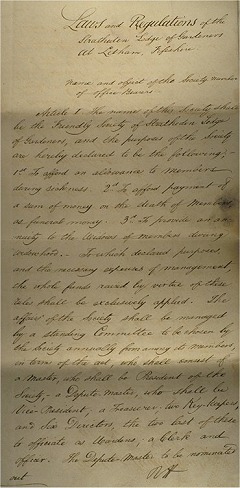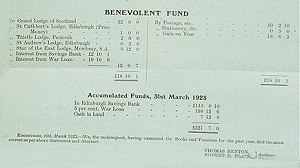Free Gardeners Home | Previous | Next

The Grand Lodges - Free Gardeners as Unity Friendly Societies
There is no systematic way of finding out which order a particular lodge of free gardeners belonged to, if any. Some lodges moved between one order and another and the orders themselves adopted different names at different times reflecting splits and unifications in the movement. The orders proliferated in the UK in the second half of the 19th century, creating themselves amidst universal enthusiasm for unity friendly societies and assisted by legislative changes that acted to promote their growth and regulate their transactions.
Workers' 'combinations' had always been viewed with suspicion by Britain's ruling classes. In the late eighteenth century this was particularly so as revolution swept America and France and the UK experienced unrest on the back of industrialisation. Acts were passed to prevent the formation of working men's organisations - their names give an idea of their intent: the Combination Act, the Illegal Societies Act, and the Seditious Meetings Act. However, societies 'for security' were allowed in 1793 under the first so-called 'Friendly Societies Act'. Many societies were careful to state that they operated 'as the Act allows' in their Articles. Even so, they had to be approved by Justices of the Peace. Further legislation followed in 1809, 1819, 1829 and 1834. A succession of Acts was passed in the Victorian period. Their effect was to sometimes promote and sometimes hinder the growth of friendly societies. The main impetus of the legislation was to promote larger organisations at the cost of smaller, local bodies. Small organisations (gardeners lodges in this instance) with a similar outlook banded together to protect their identity and survive: they created Grand Lodges. In 1875 an Act was passed to modernise audit and registration of the sector, which had grown to include nearly 30,000 bodies with millions of members!

The twentieth century brought further changes. These first assisted and then, more or less, destroyed the whole edifice of friendly societies, leaving very few survivors.
In 1908 the first Old Age Pensions Act came into force, providing 5/- (25p) weekly for those over 70; this acted against the friendly society sector, whose members had been in effect paying privately for their own provision. Then in 1911 the Liberal Government passed a National Insurance Act. Every worker between 16 and 70 had to join, paying a small weekly sum themselves, to which was added an increment from their employer and another from the State. In return they were guaranteed sickness benefits. Prior to the Act only those who had joined a friendly society had had this protection. The Act had to be administered and the friendly societies, that had been the 'private sector' providers up until its introduction, were enlisted to operate the new scheme. Societies became 'approved societies' and were responsible for delivering National Insurance: their membership grew to around 14 million. To be 'approved' a society required more than 10,000 members: this drove many of the smaller societies to affiliate or close. In 1945 a Ministry was created and civil servants took over the delivery of National Insurance and the days of friendly society mass membership passed away.
Free Gardeners Home | Previous | Next